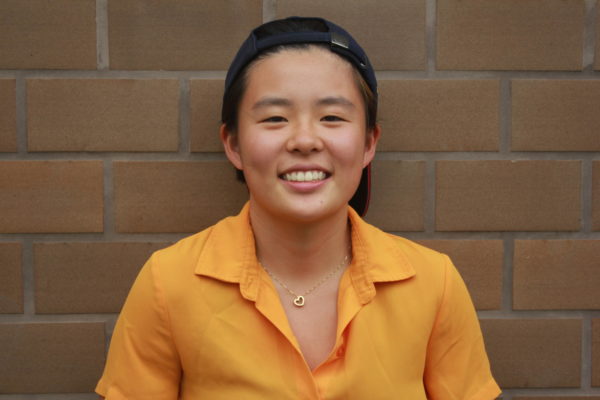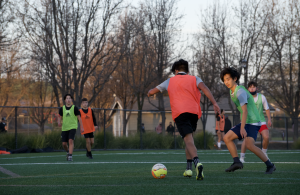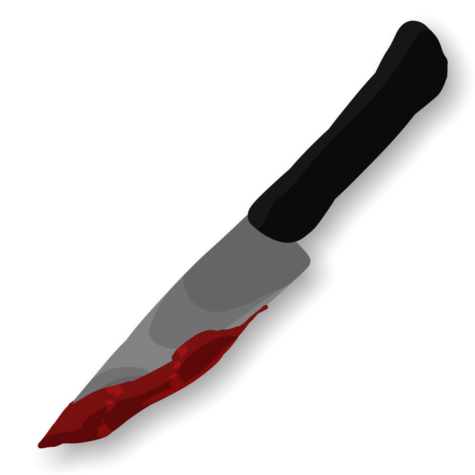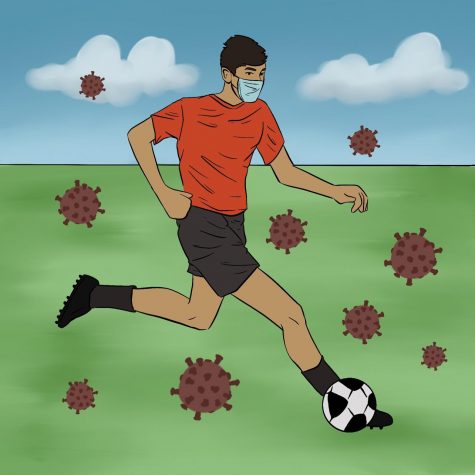Local youth soccer clubs keep the ball rolling amidst COVID-19 safety regulations
Some players disclosed sensitive information about their clubs in this article under the condition of anonymity; pseudonyms are indicated with ‘*’.
On March 11, 2020, Italian soccer club Juventus’ defender Daniele Rugani contracted COVID-19. What followed was one of the most consequential days for virtually all professional sports. European soccer leagues, the NBA, the MLB and other major sports leagues all suspended their seasons indefinitely.
Losses slammed leagues hard — too hard. The Premier League (the top level English soccer league) was projected to lose a total of $1.46 billion from COVID containment measures, an alarming number compared to their total 2018 revenue of $2.1 billion. To mitigate financial damage, leagues slowly scheduled games starting in late June 2020, though with a limited — often absent — audience.
The reopening has not been easy. The Premier League itself has recorded 207 cases across its 20 clubs since last August. Even soccer celebrities including Cristiano Ronaldo and Kai Havertz contracted the virus, and many players infected continue to experience health problems after recovery.
Professional soccer clubs boast millions of dollars in revenue, teams of medical experts at their disposal, and a host of other resources to protect them from the worst — and yet COVID has torn down almost all those safeguards in some capacity.
With even massive, international clubs struggling, how are local youth soccer clubs — which have a mere fraction of the resources that professional teams have — managing to stay afloat, safe and competitive?
The main competitive youth soccer clubs in the Tri-Valley area — Pleasanton RAGE, San Ramon FC (SRFC), Mustang Soccer League and Ballistic United Soccer Club (BUSC) — are all adapting to the pandemic in their own ways, but the process is far from seamless. Changing county and state orders coupled with alleged issues with safety protocol enforcement are a few of the obstacles that some local clubs have faced with reopening.
Shutting down, reopening and adapting to COVID
The pandemic shut down all club practices in the Tri-Valley area around the same time: mid-March of 2020. Quarantine began, putting life (including soccer) on pause. But not for long. Most local clubs — such as RAGE and BUSC — transitioned to virtual team practices (through platforms like Zoom), entailing backyard-friendly drills, player development sessions and even guest speakers (BUSC invited San Jose Earthquakes’ player Tommy Thompson to three to four special virtual practices).
Simultaneously, plans to get back on the field safely and quickly were already in the works. Fred Wilson, Mustang’s executive director, was part of an inter-club effort to get back-to-play guidelines produced and presented to local government officials.
Among many other individual coaches and club directors, Wilson worked with clubs from southern California to Dallas as well as government writers to draft a 10-page document of sanitation and social distancing protocols that many local soccer clubs (including Mustang) and teams nationwide eventually practiced in their early back-to-play stages in mid-June.
Some of the common practices that most of the clubs follow include: using distanced, drawn-out “grids” or “boxes” for individual players to use during team practice, sanitizing balls and personal equipment after practice, requiring masks to be worn before and after practice, and limiting team sizes to 14 players.
Throughout the summer, Contra Costa County slowly started rolling back strict safety measures and soccer clubs followed. Grids were no longer utilized at every practice, and some intra-club scrimmages were allowed, though contact was still limited.
However, a resurgence in COVID cases in late November quickly put an end to any easing of safety regulations. On Dec. 6, California went back into strict lockdown under Governor Gavin Newsom’s regional stay-at-home order (the order was lifted on Jan. 25).
Around the same time as the lockdown order, the California Department of Public Health (CDPH) released an updated set of guidelines for youth sports. Now, all players must wear masks during practice, no intra-club scrimmages are permitted, indoor facilities must not exceed 25% occupant capacity and the capacity to which clubs can operate is tied to county tiers.
Soccer is listed as an “outdoor high-contact sport.” For these sports with this classification, competition can only occur within the county or adjacent counties at the orange tier (or better).
Though Contra Costa is still in the red tier, Dan Chamberlain, executive director of SRFC, expressed appreciation for “a pathway back to competition.”
As of the past few months, guidelines continue to change at a fast pace. Overall, restrictions appear to be loosening.
“Outdoor high-contact sports” received the green light from the CDPH to commence in purple and red tier counties with a “case rate equal to less than 14 per 100,000” on Feb. 26. Currently, both Alameda and Contra Costa counties meet this requirement, and games are starting to be rescheduled.
Additionally, a March 5 CDPH order allows all indoor and outdoor youth sports to resume if rigorous weekly testing is conducted, but, so far, no local clubs have pursued this option.
Differences in club safety guidelines: testing, temperature checks and competition
Aside from county COVID protocol and some common safety standards (as outlined in the collaborative document that Wilson contributed to), local clubs have some level of freedom when it comes to determining what their COVID-prevention plan looks like because they are (for the most part) privately operated.
Additionally, a lack of specific COVID guidance from the county and state concerning the oversight of youth sports clubs has expanded opportunities for clubs to build upon existing decentralized authority.
One of the clubs that has taken advantage of this autonomy is Mustang. From the last week of July through the final week of September, Mustang carried out something that no other local club did: their own COVID-testing program. Every Wednesday, all players and active coaching staff were tested (via nasal swab), and those tests were shipped overnight to ApolloMDx Labs in Houston, Texas.
By Friday morning, Wilson would begin receiving the results of the tests through an online portal. It was an efficient program, helping Mustang reduce many uncertainties with their players. Throughout the duration of the program, over 1,000 members were tested, with five confirmed positive cases.
“The county was taking 10-14 days to get testing back. So, if somebody gets exposed, they might as well do a 14-day quarantine. The point of the [testing program] was to make it available to our members and get results in 36-48 hours,” Wilson said.
The program was shut down in September due to a California mandate that requires individual insurance providers to approve COVID-testing for their patients instead of external doctor groups, which Mustang used to bill tests for their players under insurance.
However, Mustang is still interested in exploring their testing options. Wilson mentioned that the club is considering nose swab antigen tests that have been promising in Europe, yielding results in “10 to 15 minutes.” After FDA approval, the tests could be administered by the club via a special medical waiver.
“The key to getting back was testing; the more people we can test, the more knowledge we have and the better off we are,” Wilson explained.
Another area of safety protocol where clubs vary in is the use of temperature checks. Mustang, SRFC and BUSC all utilize TeamSnap, a mobile app that allows sports teams to conduct daily COVID-screening surveys (including self-reported temperature checks). Club-administered temperature checks are also required before each practice (for BUSC, this only applies to their indoor practices).
RAGE is the outlier. Tami Shadle, Director of Operations at RAGE, indicated that conducting temperature checks in person would be “incompatible with social distancing,” as players would have to come in close proximity with a staff member to have the temperature check accurately registered.
Dr. Christine Boyd, RAGE’s medical advisor and Stanford Children’s Health medical director of sports medicine, furthered that temperature checks are not the “end-all-be-all safeguard” anyway.
“Checking temperatures is not super reliable, especially in the setting where it’s just checking the temperature in your head,” Boyd said, adding that “if players are not having any contact with each other, then the risk of transmission is very low and the need to screen temperature is probably low as well.”
Regardless, Shadle and Boyd explained that players are instructed to record their temperatures at home before practice and notify their coach if it is abnormal or if they are feeling unwell.
Despite this expectation, players like Faye Szeto and Haley Hong, juniors at Dougherty Valley High School and a part of the RAGE 04 Orange Team and 04 ECNL Team (respectively), stated that there are no enforcement mechanisms in place to guarantee that players were self-checking their temperatures. The club also recently implemented TeamSnap for self-screening surveys, but Szeto indicated that, similar to temperature checks, there seem to be no consequences for not filling out the screening questions.
“I don’t think a lot of us even [check our temperatures] at home,” Hong added.
In response, Boyd and Shadle both stressed the importance of personal player responsibility as a major factor for keeping players accountable.
“At RAGE, it’s just an expectation that the players assess for their symptoms,” Boyd said.
The most even split in club policy alignment lies in one area: competition.
Because of state restrictions, the only competition opportunities available are in neighboring states. Though the updated travel advisory of Jan. 6 now suspends out-of-state travel, local clubs held — and still hold — conflicting stances on competition leading up to that change.
In November, Mustang sent four of their Girls’ Elite National Competitive League (ECNL) teams to play in the ECNL Arizona Fall tournament in Phoenix. BUSC also sent a few of their top teams out of state to play, but for practice only. Ezrah Serralde, a junior at Dougherty Valley High School and player on one of BUSC’s Academy teams, traveled to Nevada the week leading up to Thanksgiving break (Nov. 21-29) with his team to scrimmage against a Sacramento team.
Prior to the travel advisory, both SRFC and RAGE opted not to compete, citing a lack of preparation opportunity as one of the main reasons behind their decision. This reasoning is also why both clubs are taking it slow even now that games are permitted in-state.
“We didn’t feel it was safe to send players to other states to play games when they can’t train appropriately beforehand. That was the driving factor,” Boyd said.
Indeed, RAGE’s COVID-19 Q&A, Information & Updates document explains that the club is focused on a “gradual return” to competition with at least two weeks of full-contact training to mitigate the “heightened risk of injury (notably ACLs and concussions)” associated with not “abiding by this progression.”
Mustang’s extensive (though short-lived) testing program, different policies on temperature checks and variations in competition policy between clubs all reflect a noticeable flexibility concerning the implementation of COVID safety regulations, something that BUSC’s Executive Technical Director of Playing and Coaching Development Kevin Crow believes can be dangerous.
“At the end of the day, coaches and players want to compete. So, if you give them any wiggle room, they’re going to use it to their advantage,” he warned.
Crow did not specify his speculations further, but the thought still lingers: are clubs following their own guidelines? Some players have an answer.
Uncertainty about adherence to safety protocol
Despite set safety protocol, some players have alleged that not all procedures are being followed to the extent their clubs claim they are. One of the common breaches of safety regulations that players have reported is the practice of contact play, such as scrimmaging. Under current California Youth Play guidelines, even scrimmaging within a team or club is not allowed.
In December, Susie*, a female player from one of the local clubs, stated that her coach did not actively enforce mask-wearing at practice or during conditioning, though it was required in club safety protocol.
She said that only four out of 15 girls on her team routinely wore masks during practice. However, she explained that “whenever parents come around or when it’s time for pick-up, [my coach tells] everyone to put on their mask because some parents are likely to snitch on the team and get [my coach] in trouble.”
Additionally, Susie claimed that her coach (along with other coaches in the club) has been “pressing practice on the down-low” by inviting players to meet up at a park or local field at a certain time. This would not classify as an official, club-sanctioned practice, so players are technically exempt from any club guidelines during these gatherings.
Similarly, Jenny*, another female player from a different club, reported that her team is actively conducting scrimmages and possession drills while they are not allowed to under county guidelines. She added that coaches are also “lenient” when it comes to prolonged contact on the field and social distancing enforcement during water breaks.
“They say the rules but we don’t follow them as much,” she said, referring to both her club as well as others.
Ethan*, a male player, corroborated these anecdotes, explaining that no one is usually monitoring the field during practices, so intra-scrimmaging and contact drills can occur.
“It happens. From time to time, we’ll play contact; we’ll do what’s needed,” he said, explaining that the team still tries to participate in socially-distanced drills more often than contact.
Overall, players have mixed sentiments about club practices and potential safety violations. Some are critical.
“It defeats the purpose of everything. We totally ruin it [safety] by getting close to each other and drinking water next to each other,” Jenny* said. Susie* expressed feelings of discontent with her coach’s leniency, as well as potentially the club’s.
“I do not feel safe. I would be lying if I said I did. [My coach] is not handling this responsibly. I think [my coach] should be setting a better example. If the [Board of Directors] is aware of this, they should be enforcing [protocol] better.”
Additionally, she pointed to the club’s encouragement towards attending optional practices as another point of concern.
“The way they word their messages [is] ‘you should be coming,’ as if it’s a commitment. They should be making sure that all players feel comfortable.” However, Susie* also continued that not all the blame rests on the club.
“It’s [also] kind of a guilt factor, where the rest of your team is practicing and you’re staying at home. You might think, ‘Am I the bad team player for not showing up while everyone else is?’”
This perspective is not shared by all players. Ethan* and Tom*, another male player, mentioned that their respective coaches are very understanding of players’ safety concerns. They both explained that they never felt pressured or obligated to attend practices or violate safety protocol on behalf of the team.
Club perspectives
Wilson, Chamberlain, Shadle and Boyd denied any safety breaches occurring during club-sanctioned practices. All local clubs utilize variations of “safety monitors” (club directors and staff) to hold teams accountable to safety protocol by dropping in to supervise team practices sporadically. BUSC and Mustang also have additional authority figures, such as a COVID officer and risk manager (respectively) that provide additional instruction to the safety monitors.
Despite these accountability mechanisms, clubs admitted that it is not that easy to regulate players outside of the club environment.
When asked about possible unofficial team practices, Wilson says that Mustang “discourages” coaches from organizing these practices and instead emphasizes that they should come to the club if they seek additional space. However, he acknowledged that group practices not necessarily led by coaches may still be occurring.
“I know that kids are playing on the weekends without our supervision; they’re going out and scrimmaging. I know our [players] are doing it too.”
Wilson added that even some former Mustang volunteers were reported to be hosting unofficial practices with players, but there was nothing that the club could do to stop them.
At RAGE, the sentiments around holding players accountable off of club grounds are similar to Mustang’s. Consistent with the stance on enforcing temperature checks, Shadle used the term “honor system’’ to describe the player-driven responsibility that the club relies on to enforce many of their safety procedures.
For example, she referenced the club’s inability to determine if a player is carpooling with another player outside of his or her family (a violation of club guidelines) and if post-travel quarantines are being respected. Ultimately, the club can only put out the recommendations, but it is up to the player and his or her family on whether or not they are to be followed, Shadle explained.
Jai Sahni, a junior at California High School and part of the Mustang Roma team, feels that no matter what clubs do, there will never be guaranteed safety.
“You can’t really be safe in a pandemic unless you’re isolated from everyone, so just playing is a risk in general,” he said.
Moving forward
Some players have opinions on how they believe their clubs should move forward. Julian Mesa, senior at California High School and a player on the Mustang Roma team, wants to see more testing available.
“At least for the club, we [should] all get tested, maybe on a weekly, bi-weekly basis.
With that, we will all be able to play with each other against other teams and not have to worry,” he said.
Many players expressed support for a continuation of the safety procedures their clubs have already created.
Suhana Singh, a junior at Dougherty Valley High School and part of Mustang’s Girl’s 04 ECNL team, believes that her club is “doing the best they can” with balancing enforcement of COVID protocol and competitive opportunities. She admitted sometimes the safety restrictions make practice “frustrating,” but both she and her team “understand why they are necessary.” Serralde also feels the same about BUSC, specifically citing distanced practices as a reason why he feels relatively safe.
Club directors and coaches also had their own opinions on the future, many of which concern the ever-changing safety guidelines from local and state jurisdictions.
When it comes to clarifying ambiguous state guidelines, Crow wants to see a more efficient process. As a youth club, he explained, it feels like “we always have questions [we can] never get answers to, trying to go through the loop” of asking the city for approval and waiting for concerns to trickle their way up to the state.
Almost all clubs agreed upon wanting to see more development in research. Chamberlain specified that his interest is in more data collection pertaining to the mental health implications stemming from the current nature of restricted play.
“I’ve had more conversations about mental health with my players over the last nine-11 months than I ever have,” Chamberlain said. “There’s no question in my mind that there are serious mental health repercussions for what’s happening to kids right now. That’s the area that I would like to see some study in because that would give us a better idea of ‘risk versus reward,’ [considering] what kids are missing right now.”
Wilson called for obtaining data that directly allows clubs to say “we can do XYZ” regarding player safety and reopening in accordance with scientific research.
Boyd had a similar opinion on the importance of research for creating accurate safety guidelines.
“More attention needs to be paid to the true risks of contact sports, because I don’t think we truly understand that. We definitely need to advocate for kids — not to put them in a risky situation — but to better understand and come up with appropriate rules and regulations for groups,” she said.
Regardless of wishes, as of now, clubs generally agree that their main role is to “continue to remind people how to stay safe” and “create a safe space for kids,” as Wilson said.
Chamberlain explains that fighting for that “safe space” is more of a priority than ever.
“We serve an important role in our community,” he said. “[If] we’re able to operate, we [can] get kids out, we [can] get them active [and] we can connect with them.”

Jade has been in journalism for two years. She was a Staff Writer and Opinions Editor. Jade has a twin sister named Crystal (they're both named after gemstones). Jade's goal for journalism this year is to write...

He had joined the Tribune because of the intricate writing styles I had observed in the campus newspaper. He has been on the paper for two years, serving as a Staff Writer and Sports Editor. He likes to consume...

Ella joined the Tribune to improve her writing skills, but stayed for the people, the experience, and the snack cabinet. She was previously photography, multimedia, and managing editor, and is now the co-editor-in-chief....



















